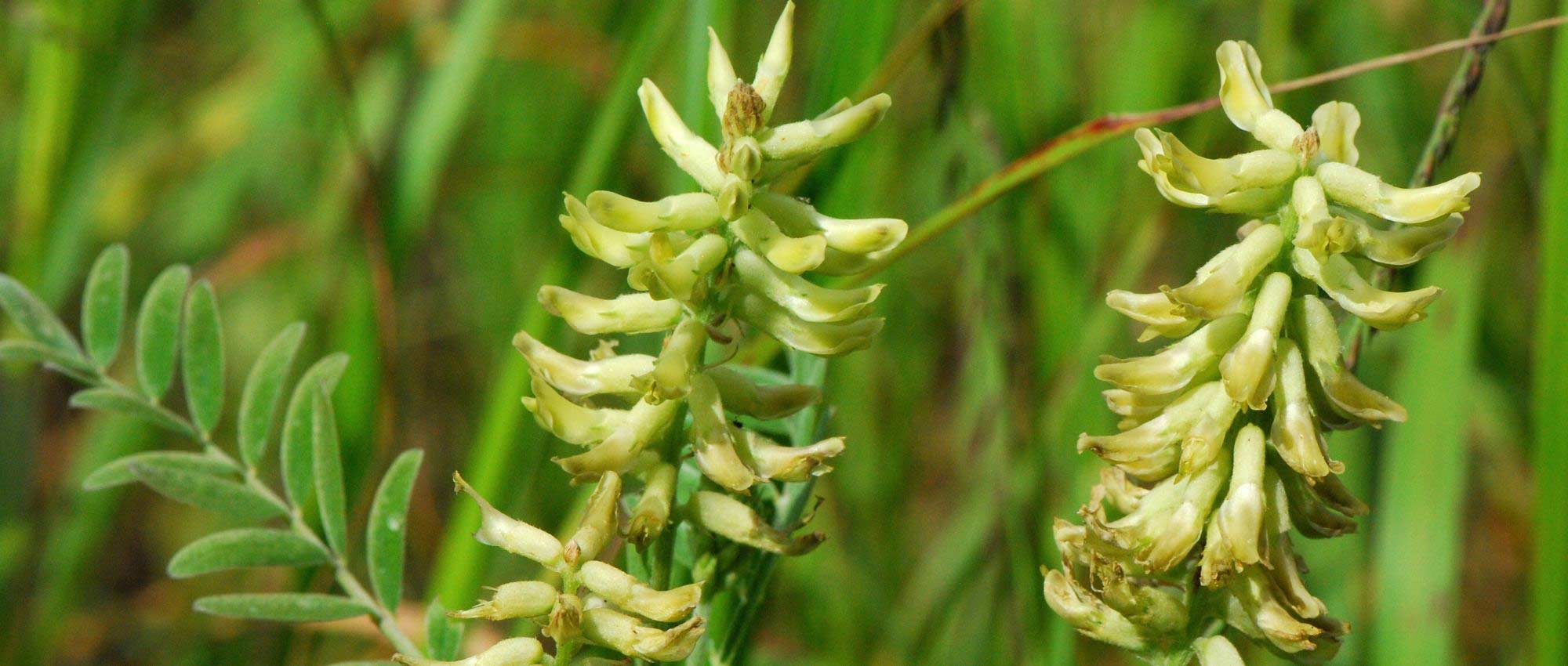
Astragalus: planting, growing, and care
Contents
Astragalus in a nutshell
- The Astragalus offers a lovely flowering in spring or summer
- Its inflorescences come in shades of white, yellow, pink, or purple
- Its finely dissected foliage is also appreciated
- The Astragalus has a very natural and rustic style!
- It thrives in full sun, in well-drained, rather dry soil.
- Some species are known for their medicinal properties
A word from our Expert
The Astragalus is a rare plant in gardens, but it deserves to be cultivated more often! It offers a lovely flowering display in soft hues and finely divided foliage. The most well-known is Astragalus membranaceus, used in Chinese medicine for its energising and stimulating properties. In the garden, there are other highly decorative species, such as Astragalus glycyphyllos, which features generous, bright green foliage and yellow inflorescences, or Astragalus centralpinus, with very fine, greyish, villous leaves.
Many Astragales are mountain plants that thrive in well-drained, sandy, or rocky soils, but they are not fussy about soil type. They are robust and sturdy plants, requiring no special care. Once established, they do not need much attention and can remain in place for years! They integrate easily into naturalistic and rustic gardens, as well as sunny rockeries and perennial borders.
Botany
“`html
Botanical data
- Latin name Astragalus sp.
- Family Fabaceae
- Common name Astragalus
- Flowering spring or summer (between April and August)
- Height between 20 cm and 1 m
- Sun exposure full sun or light shade
- Soil type well-drained
- Hardiness generally down to -20 °C
Astragales constitute a vast plant group, encompassing a great diversity of plants that can be annual or perennial. Most are herbaceous, but there are also shrubby species. With 2,450 species, Astragales represent the largest botanical genus in terms of described species. The ornamental Astragales cultivated in gardens are predominantly perennial, herbaceous, and deciduous. They are robust, quite hardy, not very susceptible to diseases, and have a long lifespan.
Although Astragales have a wide global distribution, they are primarily found in temperate regions of the Northern Hemisphere. Astragalus membranaceus, used in Chinese medicine, is native to China and Mongolia, while Astragalus canadensis hails from North America. Some species grow naturally in France, such as the Montpellier Astragalus (Astragalus monspessulanus) and the liquorice-leaved Astragalus (Astragalus glycyphyllos).
Astragales belong to the Fabaceae family, also known as Legumes. This family includes beans, broad beans, lentils, soybeans, and clover… Many Fabaceae are used for human consumption or as fodder. There are also ornamental plants, such as wisteria, sweet pea, and lupin… Fabaceae have the unique ability to fix nitrogen in the soil by associating with bacteria at their roots. Some species are even used as green manure to enrich the soil.
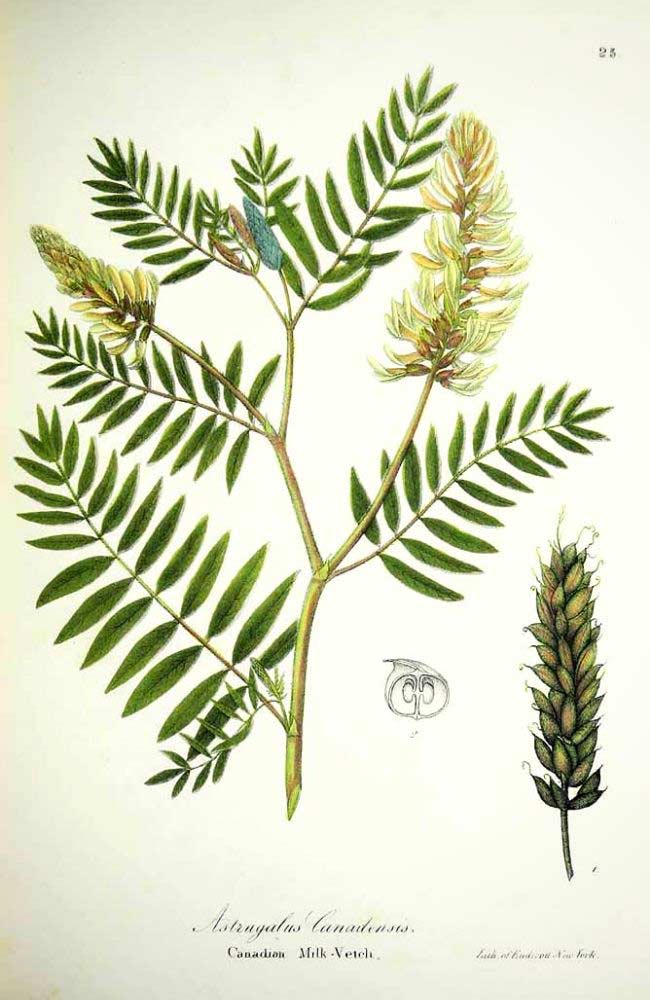
Astragalus canadensis: Botanical illustration
Astragales have a relatively loose and flexible habit, very airy. Their size varies, as they can reach between 20 cm and 1 m in height. They are not very tall plants, and their stems are sometimes spreading (as seen in Astragalus glycyphyllos). Some species are mat-forming or creeping. For example, Astragalus balearicus forms very dense cushions.
Depending on the varieties, Astragales flower in spring or summer (between April and August). The Montpellier Astragalus, for instance, flowers in spring, while Astragalus membranaceus and canadensis bloom in mid-summer.
The flowers of Astragales are gathered in more or less dense clusters, either rounded or elongated. They form stunning pom-poms, reminiscent of clover flowers, and sometimes appear very soft, as in Astragalus alopecurus, which earns it the nickname “Fox-tail Astragalus.”
The flowers are irregular, with bilateral symmetry, and are characteristic of the Fabaceae family. Like Peas or Clover, the flowers consist of five petals, divided into three types: the banner (the upper petal, larger than the others), the wings (two lateral petals), and the keel (two ventral petals), which protect the ten stamens and the pistil. The flowers are therefore hermaphroditic, bearing both male and female organs. At the base of the flower, the petals are surrounded by a tubular calyx with five teeth, corresponding to the sepals.
The flowers of Astragales are melliferous: they attract pollinating insects, particularly bees.
The flowers can come in various colours: yellow, white, pink, red, purple… Generally, the shades are rather soft, in pastel tones. Astragalus onobrychis bears stunning purple flowers.
After being pollinated, the flowers of the Astragalus give way to pods that contain the seeds. These pods open when mature to disperse the seeds.

The flowering of astragales: from left to right, Astragalus centralpinus (photo by Meneerke Bloem), Astragalus canadensis (photo by Matt Lavin), and Astragalus onobrychis (photo by Stefan Lefnaer)
Astragales possess beautiful foliage divided into oval leaflets. The number of leaflets varies greatly, from Astragalus glycyphyllos, which has only 4 to 6 pairs of broad, developed leaflets, to Astragalus alopecurus, which has up to 40 pairs of narrow leaflets. The leaves are green, sometimes greyish or whitish. They are often pubescent on the underside.
The foliage of Astragales is deciduous, drying out in autumn with the cold temperatures, and reappearing in early spring as soon as the weather warms up.
Astragalus membranaceus is known for its medicinal properties. It has been used in traditional Chinese medicine for thousands of years and is called “Huang Qi.” Its long taproot is harvested, ground into powder, and can be used in decoction. It helps combat fatigue, restores energy, stimulates the immune system… It is also anti-inflammatory and adaptogenic.
Astragalus gummifer is also a utilitarian plant, from which sap is extracted to obtain tragacanth gum. This gum has medicinal properties and numerous industrial applications (due to its waterproofing, adhesive, gelling, and thickening properties…). Other species of Astragales are cultivated as fodder for animals.
 Astragales bear beautiful divided leaves. Here, Astragalus glycyphyllos (photo by Benjamin Zwittnig), Astragalus alpinus (photo by Antti Bilund), and Astragalus monspessulanus[/caption>
Astragales bear beautiful divided leaves. Here, Astragalus glycyphyllos (photo by Benjamin Zwittnig), Astragalus alpinus (photo by Antti Bilund), and Astragalus monspessulanus[/caption>
“`
Read also
15 plants for a sunny rockeryThe main varieties of Astragalus
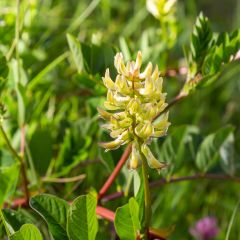
Astragalus glycyphyllos - Milkvetch
- Flowering time February
- Height at maturity 70 cm
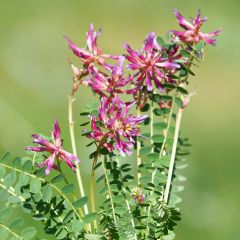
Astragalus monspessulanus - Montpelier milkvetch
- Flowering time February
- Height at maturity 10 cm
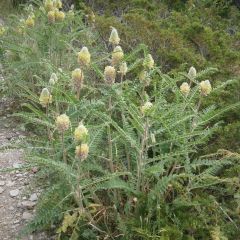
Astragalus centralpinus - Milkvetch
- Flowering time February
- Height at maturity 70 cm
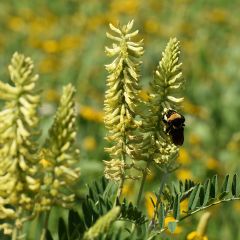
Astragalus canadensis - Canadian Milkvetch
- Flowering time July to September
- Height at maturity 1 m
Discover other Astragalus
View all →Available in 1 sizes
Available in 1 sizes
Available in 1 sizes
Available in 1 sizes
Planting
Where to plant?
Astragalus require perfectly drained, rather dry soil. They do not like heavy, waterlogged soils that could suffocate their roots. The species Astragalus membranaceus and alopecurus particularly appreciate sandy, loose, and deep soils. Astragalus are low-maintenance plants. The ornamental species are quite hardy, so they can be grown without issue throughout France, even in mountainous regions. They tend to grow larger and more vigorous when cultivated in fertile and relatively cool soil. Regarding pH, Montpellier Astragalus thrives in calcareous substrates. Overall, for other species, the ideal is neutral or slightly calcareous soil.
As for exposure, preferably plant in full sun! Astragalus needs a well-lit location. However, some species accept partial shade (for example, Astragalus glycyphyllos, which naturally grows at the forest edge).
In the garden, astragalus will be perfect in a naturalistic meadow, alongside other plants with soft and airy flowering, such as Salvia pratensis, Pennisetum orientale, hastate verbena, or Knautia. Montpellier Astragalus will easily find its place in a sunny rockery, alongside sedums, houseleeks, Phlox subulata… Astragalus can also be planted at the border, with other perennials.
When to plant?
You can plant Astragalus in spring, around April-May, or in autumn, around October. The most important thing is to avoid periods of frost or extreme heat, which could weaken the plant at the time of planting.
How to plant?
- Dig a planting hole, measuring about twice the size of the root ball.
- Add drainage elements if necessary: coarse sand, gravel… You can also add some well-decomposed compost.
- Remove the Astragalus from its pot and plant it in the planting hole.
- Replace soil all around, then firm it down.
- Water generously.
- I recommend installing a mulch, either organic or mineral.
Astragalus can also be planted in a pot, in a draining substrate, and placed on a terrace, for example.
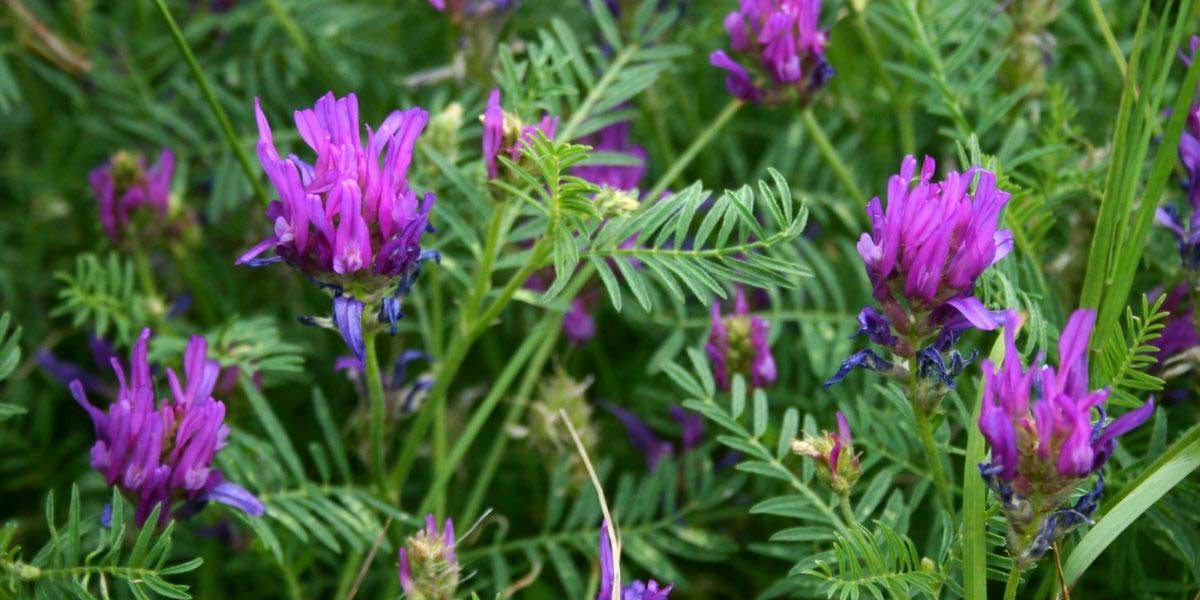
Astragalus onobrychis (photo Franz Xaver)
Entretien
Astragalus plants appreciate regular watering, especially during their first year of cultivation. As the roots are quite thick and deep, once established, they tolerate drought fairly well. However, cool soils make them more beautiful and vigorous, which is why you can continue to water them occasionally. Don’t hesitate to add a layer of mulch around them to maintain soil moisture. You can also add a bit of compost from time to time to enrich the soil. I also recommend cutting back the clump each year at the beginning of spring and removing any dead or damaged leaves.
The Astragalus is quite hardy, so it does not need to be protected in winter. It is also not susceptible to diseases or pests.
If you are growing Astragalus membranaceus for its medicinal properties, wait at least four years before harvesting the roots. To harvest them, intervene in spring or autumn. Always remember to leave part of the clump and the main roots in the ground. Take a portion of the roots, wash them, and then dry them. You can also grind them into powder or cut them into small pieces for culinary use.
Multiplication
Astragalus can be multiplied by sowing or division. Some species even lend themselves to propagation by cuttings. If your plants are well-developed and spreading, I recommend division, as sowing yields unpredictable results and takes more time.
Sowing
Seeds should be sown in spring, after undergoing a cold period (vernalisation). To do this, place them in the refrigerator for at least three weeks. This step helps break the dormancy of the seeds and improves the germination rate.
- Take a pot and fill it with a mixture of potting soil and sand. Lightly compact it and level the surface to create a flat area.
- Spread the seeds evenly across the surface.
- Cover with a few millimetres of substrate.
- Gently compact.
- Water with a fine spray.
- Place the pot in a bright location, out of direct sunlight.
Ensure that the substrate remains moist until germination, watering occasionally.
Tuft Division
The best time to divide Astragalus is in autumn. Identify a well-developed tuft that has been in place for at least three years, and carefully lift it from the ground, digging wide enough to avoid damaging the root system. Divide it into several segments, each with roots and new shoots. Prepare the soil for replanting in a new location, then water generously and apply mulch.
Association
With their gentle flowering and finely cut foliage, astragales create an impression of freedom and transparency. Their style is perfect for integrating into a naturalistic garden, reminiscent of a wildflower meadow. The best suited are Astragalus canadensis and A. centralpinus. You can pair them with other plants that have a very free and airy habit, such as Meadow Sage (Salvia pratensis), Scabious, Teasel (Dipsacus fullonum), and Echinops ritro… Also discover the Hastate Verbena, which bears slender blue-violet spikes in summer, or the stunning Veronicastrum virginicum, a still relatively unknown perennial that offers elegant, long terminal spikes in white, mauve, or pink. Also incorporate grasses, such as Pennisetum or Briza media. This type of garden will have the advantage of requiring almost no maintenance!
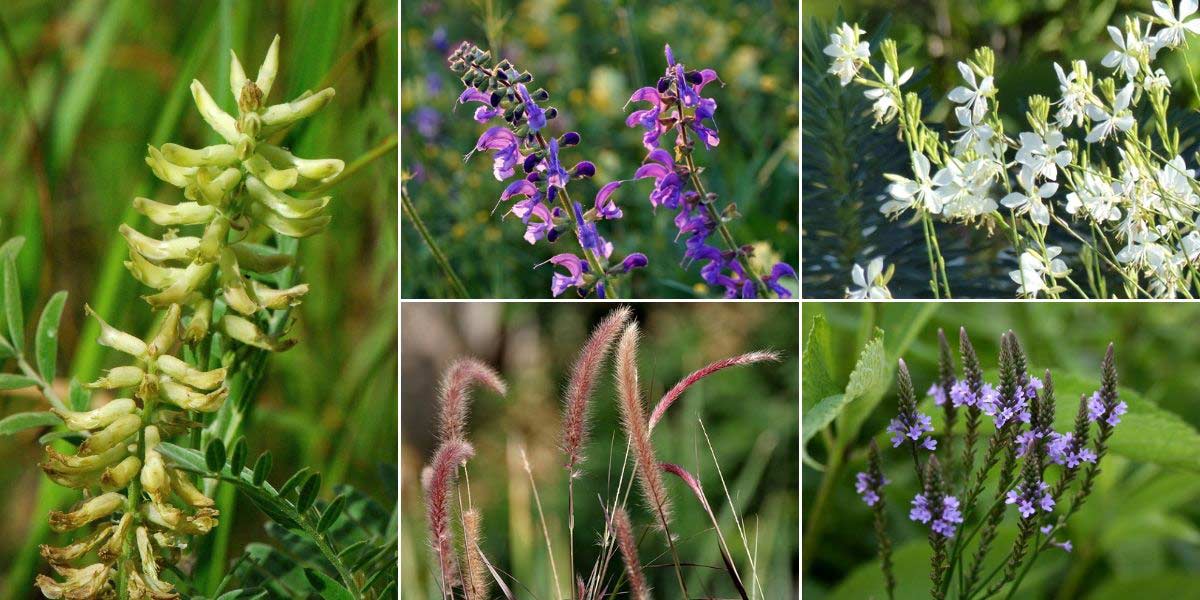
Astragalus canadensis (photo Joshua Mayer), Salvia pratensis (photo Roman Eisele), Gaura lindheimeri ‘Snowbird’, Pennisetum setaceum, and Verbena hastata (photo Cody Hough)
Because they thrive in well-drained soil and full sun, astragales will easily find their place in a sunny rockery. I particularly recommend Astragalus monspessulanus. To accompany it, favour ground-hugging or cushion-like plants that you can place between the stones. You might choose, for example, houseleek, sedum, Phlox subulata, Arabis caucasica, Eryngium, Cistus, Aubrieta… You can even integrate the fern Cheilanthes lanosa!
For more ideas and inspiration, check out our advice sheet: “15 plants for creating a sunny rockery”.
Astragales can also simply be integrated into a perennial border, alongside, for example, Echinaceas, hardy geraniums, Gaura lindheimeri, Cosmos… For a beautiful harmony of colours, favour flowers in soft, pastel shades, with small touches of bright yellow to bring luminosity, for example with Phlomis fruticosa.
Finally, you can grow Astragalus membranaceus alongside other medicinal plants: common sage, marigold, valerian, German chamomile, St. John’s wort… This way, you’ll have a supply of plants for natural healing and to prepare herbal teas or decoctions!
Useful resources
- Discover our range of Astragalus
- To pair with Astragalus, explore this Naturalist Garden atmosphere
Frequently asked questions
-
I want to grow Astragalus for its medicinal properties, how to do it?
Only Astragalus membranaceus is interesting to grow for its properties; the other species are mainly ornamental. You can plant it in open ground, in a sunny location, but wait at least four years before you start harvesting the roots.
-
Do I need to add fertiliser?
Astragalus doesn't really need fertiliser; it grows easily in poor substrates. Moreover, as it belongs to the Fabaceae family, it naturally fixes nitrogen in the soil, so it doesn't require nitrogen fertilisation. However, in rich and fertile soil, it tends to become larger and more vigorous, while in dry and poor conditions, it will be much smaller... so it wouldn't hurt to add some well-decomposed compost in autumn.
-
Can I plant it in the shade?
Most Astragalus species require sunlight; however, Astragalus glycyphyllos grows well in light, not too dense shade.
- Subscribe!
- Contents
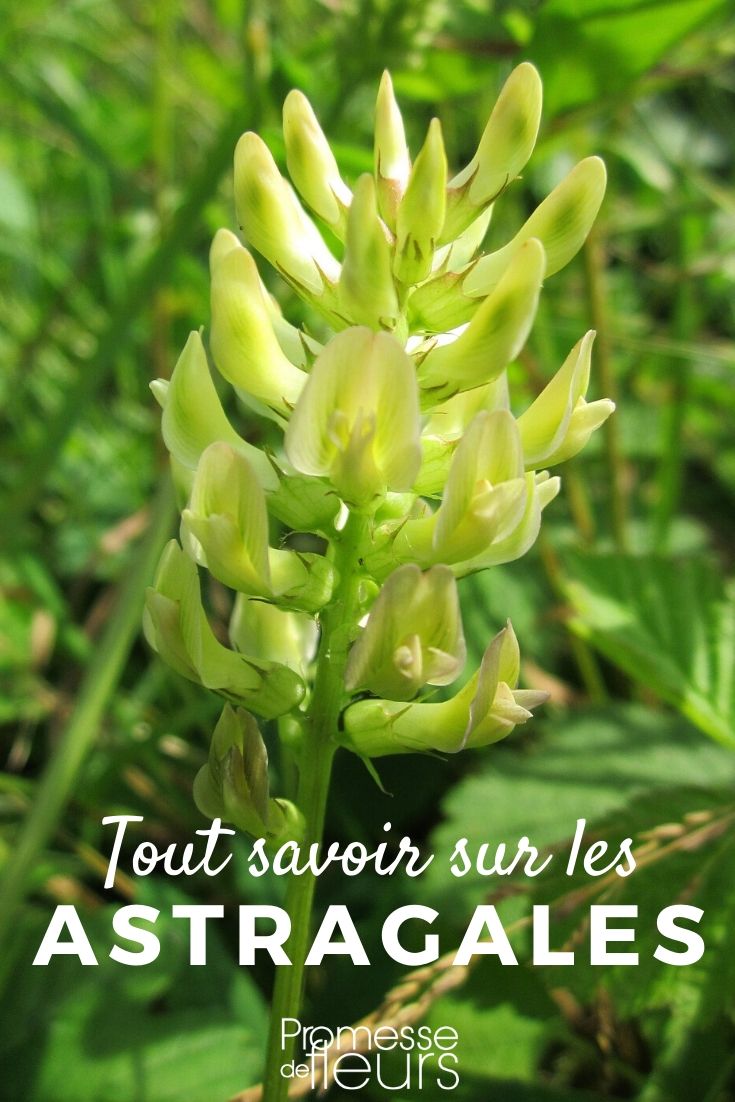



































Comments